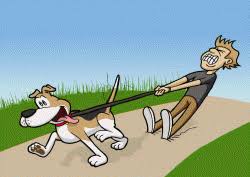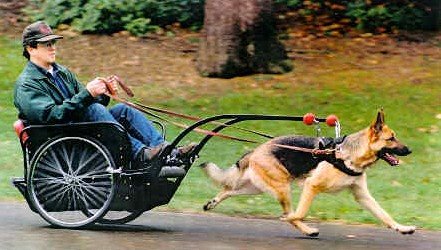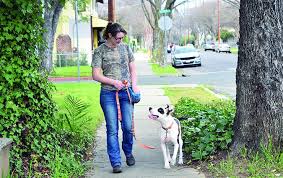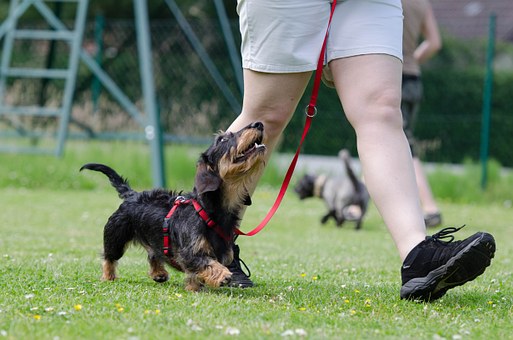
That is the first thing most people say when I ask what they want to learn in a training class. “How to stop my dog pulling on the leash”

Why do dogs pull on leash?
First we need to understand why dogs pull on leash, before we work on stopping the dogs pulling on leash. Mostly it’s because they want to check things out, or want to go faster than we are going. If you are running, many dogs still think you are too slow! Or all those great smells off to the side that they could check out if they could just get over to them!
How do I stop my dog pulling on the leash?
You train him to walk politely! He needs help to figure out it’s nicer to walk without pulling! The longer your dog has been pulling on leash, the longer it will take to change the behavior–but is well worth doing! A walk is so much more pleasant if your dog isn’t dragging you or trying to. And we want to enjoy our dog, and enjoy doing things with him!
What equipment do I need?
There are a lot of things being sold to stop pulling. First let me say that the old “correction” of a leash jerk or snap just plain doesn’t work, and is detrimental to your relationship to your dog. When you see someone yanking their dog to stop it pulling, ask them how long has their dog been pulling. Often it is years–it just plain doesn’t work!
What about pinch or prong collars? In my opinion they should be banned. Pain is not the way to train a dog, if you want a happy, well-adjusted dog! “Oh, it doesn’t hurt”. Then why does it work? It is pain, or the threat of pain. When you change to a regular collar, the pulling returns–because there hasn’t been any training, just the threat of pain! Is that the relationship you want with your dog?
Shock collars rarely work for pulling because few people have the timing to use them effectively. (That sounds as if I approve of them, which I emphatically do not!). If you have to shock a dog more than once or at most twice for a given behavior, it isn’t training, it’s abuse. And wouldn’t you rather have your dog working with you because he wants to, rather than because he’s afraid not to?
People who do use shock collars always tell me they have never used the shock, just the vibration. Rubbish! The vibration works because it threatens a shock!
Vibration collars (without a shock choice) can be used as a signal, for instance with deaf dogs. But there it is the training making the vibration a cue, to replace verbal cues. Great tool if you have a deaf dog!
So what about choke collars? If you have one, throw it out. They are abusive, and cause a lot of damage to dogs’ throats, airways and thyroid glands.
What about a regular flat collar? This works well if you are actively working to train your dog not to pull, and he is not gagging himself or hitting the end of the leash with a jerk. If this is happening, you again run the risk of damage to the dog’s throat, especially the trachea in little dogs.

Gosh, what do I use?
If a plain collar isn’t the best choice for your dog, a harness may be a much better choice. But not all harnesses are created equal!
For many dogs, a harness that hooks on the back, as most of them do, actually encourages pulling! The back attachment allows the dog to lean into the chest part and pull away. Think of sled dogs or weight pulling dogs, this works well for them. Also, you are trying to control the dog from the middle of his back, not up by his front.

There are some front clip harnesses, with the attachment on the chest, which work very well. It keeps the dog from leaning into the harness by turning him very slightly. It also puts you level with the dog, rather than always behind him.

By far my favorite front clip harness is the Two Hound Design freedom harness. I like it because it has a front clip attachment, but doesn’t pull up under the front armpits the way so many front clip harnesses do. It actually has a front clip and back clip. I prefer to use just the front clip, as that is the one that discourages pulling. Most people use both clips, with a double ended leash, as it keeps the harness from being pulled off center. Either way works.
Very small dogs may do better with a back clip harness, because they have such a tendency to be stepping over the leash with the front clip.
Let’s get to the training part!
So now we have our dog in a flat collar or appropriate harness. Now, make up your mind that your dog is not going to pull on the leash, and neither are you. What, me? If you use the leash to drag the dog away from things, rather than calling or urging him away, you are telling him it’s okay to pull.
You can start the training by working on him being able to stand calmly next to you without pulling. Start with your dog on leash, and several yummy treats in one hand. Praise and reward when your dog is calm and/or looking at you.
If your dog pulls away from you, don’t yank on the leash or reel him back in. Stand still and wait for him to turn back to you, praise and reward. If he is very distracted, call his name (once), and make noises to encourage him back to you. I use kissy noises, “pup-pup-pup”, whatever will get him to come back to you–and praise enthusiastically and treat. If a sound doesn’t work in a few seconds, change to a different one. No point in repeating what isn’t working at that time. That is why I say use his name once, not over and over again. When he realizes treats are involved, he’ll get much easier to get back to you.
If you use the clicker (see the post Clicker Training, Great Communication), this is a great time to use it. Once we get walking, it is also very valuable, but I find many people find it too difficult with the leash and treats and the clicker. That’s okay, you can use your marker word “yes”, or just use praise.
The next step is to start walking without pulling. There are MANY ways to work on this, and you need to see what will work for you and your dog. If you have been doing the stationary exercise above, you can take a step or two, and reward with those yummy treats if he doesn’t dash forward. If he does, stop and wait until there is some slack in the leash (you may have to urge him back to you at first), then praise and reward. Keep praising and rewarding every few steps that he isn’t pulling. Keep him guessing.
Sometimes reward after 1 step, then 5, then 2, etc. You are making it worth his while to walk without pulling!

Red light-green light
If you stop when your dog pulls on the leash (red light) and resume walking when the leash is slack (green light), many dogs will give up their pulling ways. This works especially well with pups or dogs who don’t have a long history of pulling. At first you won’t cover much ground, and may become discouraged! Cheer up, it will get better.
Many folks don’t have the patience or desire to wait for the dog to give up pulling and slacken the leash. You can call him back to you, just as you did in the stationary exercise above, and praise and reward when he slackens the leash to return to you. When the dog isn’t pulling, be sure to tell him how great he is, and give him some tasty treats. It’s easy to forget to reinforce the good behavior of not pulling! Treats, praise, happy talk, smiling at him–it will all make him more eager to stay connected to you on his walk and not just forge ahead.
If your dog is really rambunctious, try changing direction whenever he pulls. At first your walk may be back and forth on the same stretch of path, but gradually he’ll catch on. Especially if he gets good interaction (that praise, treats, smiles, happy talk) when he isn’t pulling.
If you want a really good book to help you teach your dog to walk more politely, Turid Rugaas has a very easy to understand system in her book My Dog Pulls. What Do I Do?
Don’t let your dog drag you!
I often see people with their dog pulling madly, their leash arm outstretched, getting “dragged” by their dog. If you let your dog pull you over to what he wants to check out, you are definitely teaching your dog it’s okay to pull. Often the dog “dragging” his person is a 6 lb. little dog!

If your dog wants to pull you toward something, say a bush or hydrant, plant yourself! If it’s a big dog, be sure to keep your elbows at your side and your weight back on your heels. If your elbows straighten, you can get pulled over! Either stop and wait for your dog to come back, or urge him back to you. Tell him he’s a good boy, and continue your walk. If it is something he can go check out, have him come back to you, sit (to say please), and then tell him “go sniff” or whatever you want to use, and let him go check out the bush. This is using something the dog really wants as a reward for good behavior–very powerful!
Teach your dog a “leave it” cue.
I like to teach a cue to let the dog know not to go to something. I use it for trash on the sidewalk, a bush the home owner doesn’t want watered, a dead bird; anything I want the dog to leave alone. It doesn’t matter what your cue word is, as long as you remember it and are consistent with it.
Training “leave it” keep several things in mind. The closer you are to the object or smell to leave, the stronger it’s pull. Start with things that are not super high value–so not a ham bone, maybe a paper wrapper. Also remember that if you give the cue as soon as the dog notices the item, it will be a lot easier for him to leave it than if he has pulled right up to it.
Place a distraction on the floor, have your dog on a leash, and walk past at a distance that will allow the dog to notice the distraction, but not reach it (think about how short you should be holding the leash). The moment your dog notices the item on the floor (a glance, an ear twitch, the slightest indication he’s seen it), say “leave it”, call your dog to you as you move by, and reward with treats, play or great attention. Your goal is to have the dog learn to leave the item without a pull on the leash.
On walks, practice “leave it” with anything you don’t want your dog to go to. Part of your walk, your dog should get to do some sniffing–it’s very important to dogs. Part of your walk you may want to keep going and get some exercise–great time for “leave it” practice! When your dog wants to stop to sniff, say “leave it” in a calm, upbeat voice, and keep on going. Remember to praise your dog for complying.
In Conclusion
If your dog has been practicing pulling on leash for a while, maybe even years, it is still possible to teach him a different way to walk (without pulling). It may be a bit of a project, but it is well worth the effort. Going on walks without getting dragged is awesome! And any dog can learn to do it. You should notice a difference right away, but it may only be a small difference at first. Keep working! The reward of a polite dog is well worth it.

Let me know how this is working for you and your dog. Leave a comment or email me directly at keith@goodtimesdogtraining.com.
Happy training!
Great article and tips for anyone who’s dog likes to drag them around. You have to take control of the situation. Well written and informative. I don’t have a pooch but if I get one and put it on a leash, now I’ll have an idea of what to do if they want to run me ragged.
And if you start working on it as soon as you get the dog, you’ll be very successful!
Very interesting article – I’m going to forward it to my uncle. He has a lovely terrier which is either always straining at the leash or veering off to the side to sniff things. I think your leave it strategy could work wonders and add much more time to the walks as much time is spent coaxing him to leave whatever he has found. His dog is fairly mature nowadays, however – do you have any guidance on how much longer training him in this way could take?
Hi. Even dogs who have been pulling for years can be taught to walk politely. It may take longer, but not necessarily. If your uncle works on being really upbeat and interesting to his dog, and is generous with rewards until the dog gets it (then you can cut down the frequency of rewards, but always acknowledge good behavior) the pooch should make good progress. And with all dog training, consistency is key!
I love working with Terriers. Many think they are “stubborn”, but I find if you can be enthusiastic they engage with you and love cooperating. Find ways to get all that energy connected to you, and you have a super-star pupil!
This is an article that was put together very well. I mean the introduction to the body and then the conclusion ties in to give a very informative and interesting post. Well done.
Great article. Everyone who have dogs as pets I h read this article. I would love to share it with others.
Feel free to share!
I think many dog owners just don’t know there are things they can do to help their dogs walk more politely on leash.
I am one of those owners whose #1 wish for our 14-month old black labrador Mochi is to stop dragging us. I will try anything to get him to walk politely. The thing I noticed about him, no matter how much he loves treats, when he’s out and distracted by his surroundings, he simply ignores the treats! Any suggestion to make the treats work?
Great post. Will follow your training tips and will be following you.
Luigi
I would try to become more interesting to him. When he pulls, turn him to go the other way and encourage him with you with happy talk and your energy. If you turn every time he pulls, you won’t be covering much ground! But in a way this is good. The environment will get less fascinating if you are retracing your steps. If every time he pulls, you turn with lots of “pup-pup-pup”, chirps, whatever he seems to pay attention to, and cheer him on when he turns toward you, he’ll get so he turns more easily. He may even get so he takes treats.
He’ll catch on that pulling doesn’t get him where he wants to go! It will take him awhile if he has been practicing pulling for some time, but he’ll catch on.
A front clip harness will really help, and be comfortable for him. I really like the Two Hound Design harness–check out my review on this website.
Turid Rugaas’ book, My Dog Pulls. What Do I Do. is also a good investment. Her method definitely works, if you use it consistently until polite walking gets to be a habit.
Another suggestion, is to work with him in the house or yard, where he doesn’t have so many distractions. Still turn if he pulls, and when he is walking nicely give treats to reward. He’ll take them if there aren’t so many great things to check out. It will set him up for success!
When I’m walking a dog, I acknowledge whenever he looks up at me. You need to give your dog as much attention as you want him to give you! With a novice dog I’ll give a treat when he looks up at me, with my experienced dogs I’ll just smile, or say a word or two to them (“good boy”, “that’s nice”). I try not to ignore my dogs when they offer me their attention–it’s too valuable!
Hope this helps. Let me know how Mochi is doing! Jane
Thanks Jane! Will use this strategy and will let you know. Appreciate the response.
Luigi